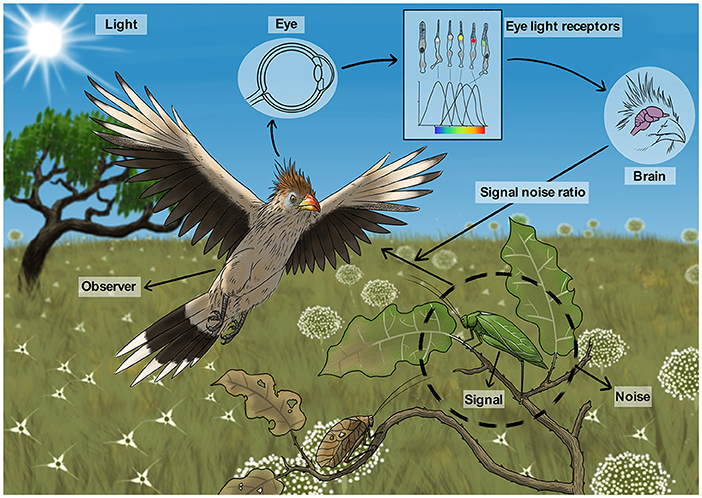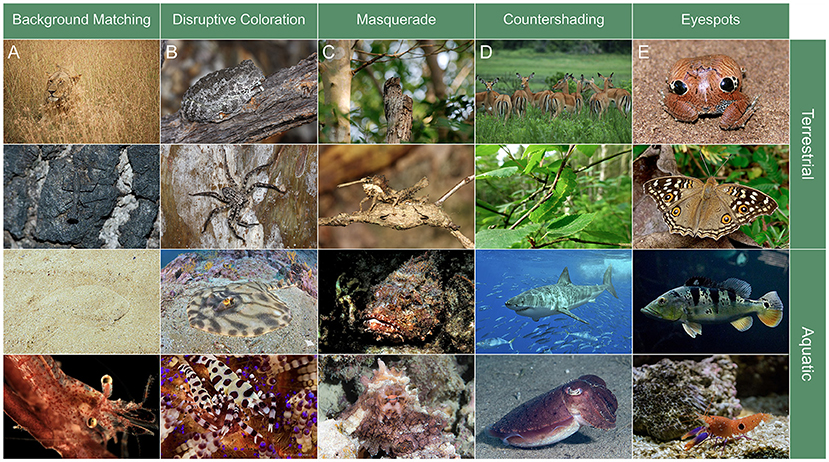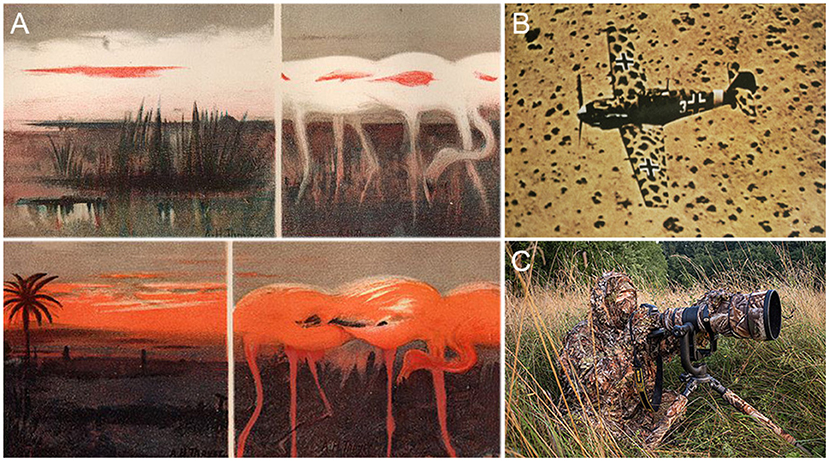Abstract
Animals use color in amazing ways, either to hide from predators or to catch prey. Camouflage is one of the most common and important tricks animals use to stay safe or sneak up on others. There are many types of camouflage, and how well it works depends on things like the animal’s color, shape, and behavior, as well as the lighting, the background, and how good the predator or prey’s eyesight is. What works well in one place might not work as well in another. People have learned a lot about camouflage by watching nature. Armies, hunters, and wildlife photographers use ideas from animals to create their own camouflage tools. Even though we admire how nature uses color, scientists are still learning and debating about how camouflage works, with many mysteries left to uncover.
Color as a Natural Invisibility Cloak
Animals use their colors for different reasons: to stay safe, communicate with each other, or hunt [1]. Interactions between predators and prey often lead to adaptations, for example, when the prey develops ways to hide or be hard to spot. Some have bright colors to warn predators that they are Toxic, while others use camouflage to blend in and hide. Camouflage is a common way animals protect themselves, helping them stay hidden [2, 3]. Examples of animal camouflage can be seen in extinct animals like dinosaurs, as well as in plants and animals alive today, and in creatures living in places as remote as deserts or deep oceans. Although most animal camouflage plays a role in protection, predators also use camouflage to sneak up on their prey [3].
There are different types of camouflage, and each type may work well against some observers but not all [4]. For example, a tiger’s orange and black stripes are easy for humans to see but hard for deer (a common prey of tigers) to notice. Deer cannot see the color orange, so through their eyes, the tiger blends in with the green forest [5]. Animals often use more than one type of camouflage to help them blend in with their surroundings.
Animals use their brains to find camouflaged creatures, like a game of “spot the difference”! The hidden creature is the signal, and everything else around it, like the background, is the noise, so a principle known as the Signal-to-noise ratio is important (Figure 1). The more the signal (the hidden creature) stands out from the noise (the background), the easier it is to see it [4]. Both hunters and prey use this idea to spot each other. Camouflage works by either hiding the signal or blending it into the noise, making the creature really hard to see. How well camouflage works depends on many things, like the colors and patterns of the background, the amount of light, and even the shape of the hidden animal’s body (Figure 1) [4].

- Figure 1 - Camouflage mechanisms in action.
- A combination of environmental characteristics are important, such as the amount of sunlight, the types of color-sensing cells in the predator’s (observer’s) eyes, the background color on which the prey is resting, and how well the background matches with the color or shape/size of the prey. The picture shows that the predator can more easily spot the unmatched prey (Photo credit © Felipe Capoccia Coelho).
Camouflage Strategies: Hiding in Plain Sight
Animals use many clever tricks to hide, and scientists have discovered over a dozen ways they do it. The most common way is called background matching. This is when an animal copies the color and brightness of its surroundings to blend in. For example, a lion blends in perfectly with savanna grasslands (Figure 2A). Some animals, like certain sea shrimp, can even change color during the year to match seaweed [6]. Chameleons are another classic example of color-changing camouflage. Another interesting strategy is called disruptive coloration. Instead of blending in, animals use bold patterns, like stripes or spots, to confuse predators and make it hard to see their shapes. For instance, a giant panda’s black-and-white fur helps it hide by breaking up its outline when viewed from far away [7]. Up close, though, the panda’s colors work more like background matching. Other examples include small frogs and jumping spiders that combine disruptive coloration and background matching to help them hide or hunt (Figure 2B).

- Figure 2 - Diversity of camouflage strategies in nature.
- Each column represents a different camouflage strategy: (A) background matching, (B) disruptive coloration, (C) masquerade, (D) countershading, and (E) eyespots. Rows indicate vertebrate (first and third rows) and invertebrate (second and fourth rows) animals from Terrestrial (land-based; first and second rows) and aquatic (water-based; third and fourth rows) environments (photo credits © Lisa H. © João Vitor de Alcantara Viana © Diego Delso © Rafael Campos Duarte © Yuri Fanchini Messas © Luis Pérez Berrocal © Christian Gloor © The Lilac Breasted Roller, © Laszlo Ilyes, © Rickard Zerpe © Tim Caro © Gopp pi Terry Goss © Rickard Zerpe © Luís Felipe Toledo © Girish Gowda © Baruc Acosta © Claudine Lamothe.
Some animals use camouflage to confuse others rather than to hide. For example, masquerade is when an animal looks like something else in nature, like a stone, leaf, or twig (Figure 2C). Camouflage through decoration is similar, some animals stick things like sand or algae onto their bodies to blend in. Other animals use movement camouflage, like zebras. Their stripes make it hard for predators to figure out where they are going when they move. Another tactic is countershading. These animals are darker on top and lighter underneath, which hides their shadows and helps them blend in. Great white sharks, penguins, and some caterpillars use this trick (Figure 2D). Scientists are still learning about some camouflage strategies, like distraction marks—spots that might draw attention away from weak spots. We know that eyespots on some animals are a super smart strategy. They can scare predators by looking like big eyes or can trick predators into attacking less important parts of the animal (Figure 2E) [3].
Effect of Environmental Changes on Camouflage Success
Changes in the environment can affect how well animals’ camouflage works. This can happen because of the seasons, random events, or things people do, like pollution, that change the colors, textures, or lighting in a habitat. A famous example comes from the peppered moth (Biston betularia) during England’s Industrial Revolution. Back then, factories released lots of pollution into the air, which made tree trunks darker and killed the light-colored lichens that grew on them. These changes helped darker moths hide better against the dark trees, while lighter moths were easier for birds to spot and eat. Later, when pollution got cleaned up and the trees became lighter again, the lighter moths became harder to see, and the darker moths stood out more.
Similar changes happen in places where fires are common, like the Brazilian Cerrado savanna. In these areas, some animals develop darker colors, a process called melanism, to blend in better after fires darken the landscape (Figure 2A, second photo—melanic praying mantis on a burned trunk) [8]. Even though we know about examples like this, there is still a lot we do not understand about how environmental changes affect camouflage. Scientists need to study this more to learn how animals adapt to changing habitats.
A Brief History of Camouflage Research
A long time ago, scientists studying butterflies in South America made big discoveries about how animals use color to survive. Henry Bates, exploring the Amazon, and Fritz Müller, working in the southern Atlantic rainforest, found patterns that led to ideas like Batesian mimicry (when harmless animals look like dangerous ones) and Müllerian mimicry (when dangerous animals look alike). These discoveries also helped support the idea of Evolution by natural selection, showing how color helps protect animals from predators. Later, scientists like Edward Poulton wrote in his essay The Colours of Animals about how colors help animals in different ways, like camouflage, warning signals, and tricks to confuse predators. Artists and scientists, like Abbot Thayer and Hugh Cott, worked together to explain ideas like background matching and disruptive coloration. Their books, such as Concealing-Coloration in the Animal Kingdom (1909) and Adaptive Coloration in Animals (1940), used amazing illustrations to show how animals use these clever strategies to survive (Figure 3A).

- Figure 3 - Early studies of camouflage in paintings and its use as a tool by humans.
- (A) Painting by Abbott Thayer (1909) showing the potential role of camouflage in different sky landscapes (dawn or dusk) and their contrasts with white and red flamingoes (photo credit © Abbott Handerson Thayer). (B) German fighter plane flying over the desert during World War II (photo from Wikimedia). (C) Wildlife photographer wearing camouflage clothing to photograph animals in a forest (photo from Wikimedia © Ragnisp © Diego Delso © Jeevan Jose).
The ideas of camouflage are not just for animals–people use them, too. For example, during World War II, soldiers and vehicles were painted with patterns or covered with objects to make them harder for enemies to spot (Figure 3B). These camouflage techniques are still used in the military today and are always improving. In peaceful ways, camouflage also helps scientists learn more about animals. For example, wildlife photographers use it to get close to animals without scaring them (Figure 3C). Studying how animals use color and camouflage inspires new ideas and helps us understand the connection between living things and their environments. In a world that is constantly changing due to human actions, understanding how camouflage works is essential for helping animals continue their natural process of adapting and surviving on our planet.
Glossary
Toxic: ↑ Something that contains poison or is harmful to living beings.
Camouflage: ↑ Colors, markings, or body features that help an animal avoid being spotted by other animals.
Signal-to-Noise Ratio: ↑ SNR tells us how much “real” information there is compared to the “messy” or confusing information around it.
Terrestrial: ↑ Animals that live primarily on land, rather than in water or air.
Evolution by Natural Selection: ↑ A process where helpful traits make some individuals more likely to survive and reproduce. Over time, this can change a species or create new ones.
Conflict of Interest
The authors declare that the research was conducted in the absence of any commercial or financial relationships that could be construed as a potential conflict of interest.
Acknowledgments
We thank the Graduate Program in Ecology (PPG-ECO), the Institute of Biology (IB), and the University of Campinas (UNICAMP) for their financial and structural support, as well as for providing access to library resources, which proved instrumental to the development of this research. JVAV was funded by the Coordenação de Aperfeiçoamento de Pessoal de Nível Superior (CAPES), grant #88887.338483/2019-00. YFM received funding from the Conselho Nacional de Desenvolvimento Científico e Tecnológico (CNPq), grant #151959/2024-2, and FAPESP, grant #2021/11832-3. FC was funded by FAPESP, grant #2024/10368-0. RCD was funded by FAPESP grants #2019/01934-3; #2022/00946-0, and by national funds through FCT—Fundação para a Ciência e a Tecnologia I.P., under project/grant UID/50006 + LA/P/0094/2020. GQR received financial support from FAPESP grant #2019/08474-8, and a productivity fellowship from CNPq (Brazil). Special thanks to everyone who kindly provided photographs for inclusion in this manuscript.
Ai Tool Statement
The author(s) declare that no Gen AI was used in the creation of this manuscript.
Any alternative text (alt text) provided alongside figures in this article has been generated by Frontiers with the support of artificial intelligence and reasonable efforts have been made to ensure accuracy, including review by the authors wherever possible. If you identify any issues, please contact us.
References
[1] ↑ Endler, J. A. 1978. A predator’s view of animal color patterns. Evol. Biol. 11, 319–364. doi: 10.1007/978-1-4615-6956-5_5
[2] ↑ Stevens, M. and Merilaita, S. 2011. Animal Camouflage: Mechanisms and Function. Cambridge: Cambridge University Press. doi: 10.1017/CBO9780511852053
[3] ↑ Merilaita, S., Scott-Samuel, N. E., and Cuthill, I. C. 2017. How camouflage works. Phil. Trans. R. Soc. Lond. B. 372:20160341. doi: 10.1098/rstb.2016.0341
[4] ↑ Cuthill, I. C. 2019. Camouflage. J. Zool. 308, 75–92. doi: 10.1111/jzo.12682
[5] ↑ Fennell, J. G., Talas, L., Baddeley, R. J., Cuthill, I. C., and Scott-Samuel, N. E. 2019. Optimizing colour for camouflage and visibility using deep learning: the effects of the environment and the observer’s visual system. J. R. Soc. Interface. 16:20190183. doi: 10.1098/rsif.2019.0183
[6] ↑ Duarte, R. C., Flores, A. A. V., and Stevens, M. 2017. Camouflage through colour change: mechanisms, adaptive value and ecological significance. Phil. Trans. R. Soc. B. 372:20160342. doi: 10.1098/rstb.2016.0342
[7] ↑ Nokelainen, O., Scott-Samuel, N. E., Nie, Y., Wei, F., and Caro, T. 2021. The giant panda is cryptic. Sci. Rep. 11:21287. doi: 10.1038/s41598-021-00742-4
[8] ↑ de Alcantara Viana, J. V., Duarte, R. C., Lambertini, C., Coelho, F. C., Martins, A. L. O., Vieira, C., et al. 2024. Differential survival and background selection in cryptic trunk-dwelling arthropods in fire-prone environments. Am. Nat. 204:E128–4. doi: 10.1086/732864
